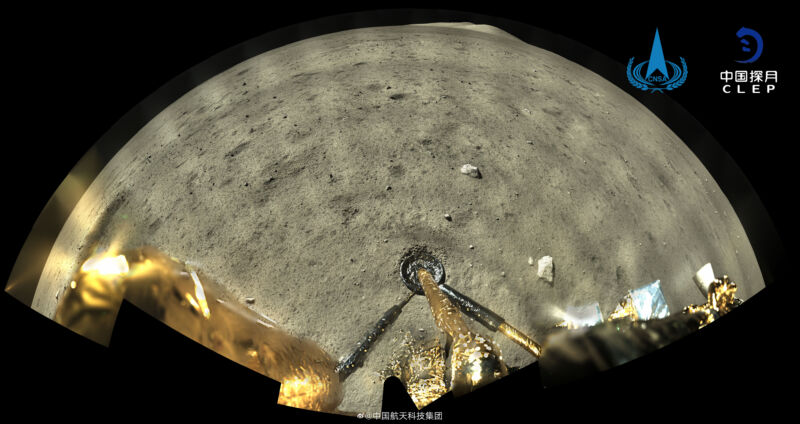There is also video showing the descent of the space
craft.
ERIC BERGER - 12/2/2020, 8:47 AM

Enlarge / This panoramic image shows the Chang'e 5 lander and the lunar landscape.
CNSA
Less than a day after its Chang'e 5 probe made a soft landing on the Moon, the China National Space Administration has released both a short video showing the spacecraft's descent to the surface as well as a high-definition image of the lunar landscape.
The panoramic surface image, highlighting the Oceanus Procellarum region where the spacecraft landed, is especially jaw-dropping. It shows the lander and one of its legs in the foreground, with the lunar surface stretching off to the horizon. This zoomable image, which measures 15,000×7,947 pixels, provides incredible detail about small rocks near the lander, as well as the indentation made by the landing leg in the Moon's surface.
The sped-up video of the descent clearly shows the Chang'e 5 lander undergoing deceleration, reorienting itself, avoiding hazards, and then hovering before coming in for a final landing.Advertisement
The landing of Chang'e 5's descender and ascender unit.
📹:CNSA/CLEP
ℹ:https://t.co/uAjm4tGl7i pic.twitter.com/P7zK9asBuq
— LaunchStuff (@LaunchStuff) December 2, 2020
Landing on the Moon is not a new feat for China. The country's Chang'e 3 probe made a successful soft landing on the Moon in 2013, and in 2019 the Chang'e 4 probe made the first-ever soft landing on the far side of the Moon—by any national space program. It's also worth noting that there are presently three active probes on the lunar surface, and all of them are Chinese.
But the real test for China's space program will come on Thursday. Since its landing, the Chang'e 5 probe has been scooping up material and placing lunar regolith into a sample return capsule. On Thursday, this small spacecraft will then attempt to launch from the surface of the Moon, something only previously done by the United States and former Soviet Union.
After this small vehicle reaches lunar orbit, it must still dock with the lunar orbiter, hand off samples, and then return safely to Earth through the planet's atmosphere. All of this, if successful, will play out over the next few weeks. Should all go well, before the end of 2020, China will have the first new samples of lunar rock returned to Earth in more than four decades.
ARS
No comments:
Post a Comment